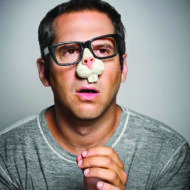
By Michele Shapiro
When a friend first showed Marta Szwedek a YouTube video on EFT tapping a few years ago, she found it funny—not ‘ha-ha’ funny, more like unusual. Szwedek, who sells antique and custom-made rugs to interior designers in New York City, was familiar with the Eastern philosophy of using acupressure points found along the body to open meridians, the pathways through which energy flows. But she had never seen someone tap on those points while also reciting an affirmation, as is done in EFT, which stands for Emotional Freedom Technique.
She found the physical act of tapping repeatedly on nine acupressure points fairly easy to master. “At first, you feel awkward, and you worry if you’re tapping the right points. But once you do it a few times, it becomes more natural.” The bigger challenge for her was mastering the accompanying “script,” which involves acknowledging that you have an emotional or psychological blockage that needs resolving and tacking on the affirmation, “But I love and accept myself anyway.”
The verbal element is what sets EFT apart from other Eastern-rooted therapies that fall under the “energy psychology” banner, like acupuncture and acupressure. “The technique incorporates a Western psychology style, for which you talk about things that are causing distress,” explains Pamela Thorp, LCSW, a Manhattan-based integrative psychotherapist who often incorporates tapping into her treatment sessions. “With clinical EFT, you can go into old memory banks and open up things that have been stored and stuck for a long time.” (She also coaches clients who want to learn the tapping basics without the analysis.)
What makes tapping such an effective healing tool, explains Thorp, is the calming effect that it has on the amygdala. “This part of the brain is like a smoke alarm. It will save us in emergencies”—but lots of times the amygdala’s danger signals are out of whack. Tapping helps to “reset” them. The practice has been used to treat a host of psychological issues, from anxiety and phobias (such as fear of flying) to emotional eating, depression and trauma.
Unlike acupuncture, which has a clearly recorded history of at least 2,000 years, EFT is a relatively new practice. Gary Craig, a Stanford engineering graduate and ordained minister, introduced it in the 1990s after he became interested in personal improvement via psychology. The practice is novel in its simplicity—unlike Craig’s predecessor Roger Callahan’s Thought Field Therapy (TFT), which relies on tapping points throughout the body, EFT focuses on nine key points, which include the “karate chop” point on the outside of the hand beneath the pinkie finger; and the “crown,” located at the center and top of the head. “The points are really powerful and easy to find,” says Thorpe. “Anytime you tap, even if you do it in the wrong order, you’re getting the benefit.”
What’s more, tapping exercises are easy to incorporate into busy lifestyles; you can employ them pretty much anytime, anywhere. “If you’re anxious before a phone call, you can tap just below the collarbone point,“ says Thorp. “Just by doing that, you lower the charge.” To learn more about the different styles and to find a practitioner in your area, check out eftuniverse.com, emofree.com, or thetappingsolution.com.
Two Tips For Tapping
To go from beginner to master tapper, here are two tips from Marta Szwedek, a New Yorker who discov ered EFT two years ago:
THERE’S NO WRONG WAY:
While tapping may feel awkward at first, don’t worry too much about doing itright. “For some people it takes a few days to master EFT, for others a few months. But eventually, you’ll get the hang of it,” she says.
DO IT DAILY:
Consistency is important when it comes to unblocking energy and experiencing those “aha”moments: “I try to tap at least once a day for 5 to 10 minutes. If you can devote 15 minutes, that’s even better.”








